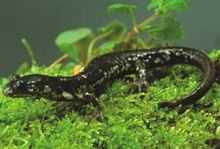Wehrle's salamander
| Wehrle's salamander | |
|---|---|
 | |
| Scientific classification | |
| Kingdom: | Animalia |
| Phylum: | Chordata |
| Class: | Amphibia |
| Order: | Caudata |
| Family: | Plethodontidae |
| Genus: | Plethodon |
| Species: | P. wehrlei |
| Binomial name | |
| Plethodon wehrlei Fowler & Dunn, 1917 | |
Wehrle's salamander (Plethodon wehrlei) is a large salamander with webbed hind feet. It is named in honor of R.W. Wehrle. The species was the first described from one of his many collections.
Description
It is bluish-black with big, scattered white spots on its back. Its sides are covered with white to yellow spots and blotches. Its belly and the ventral surface of the tail are solid gray, and the throat and upper chest usually have white or yellowish blotches.[1] The species grows to a length of 10–17 cm (4-6⅝ inches).
Reproduction
Mating occurs from fall through spring. A large cluster of eggs is laid in early summer in damp logs, soils or moss, and in crevices in caves. Reproduction is biennial or irregular, with many mature females failing to breed each year.
Behavior and Habitat
This species stays under cover during the day, and comes out to forage at night. This species is found on forested hillsides in the Appalachian Plateau, where it hides by day beneath stones or rocks. It is also found at the entrances of caves and deep rock crevices, as well as burrows under rocks and logs.
Geographic range
Wehrle’s salamander ranges from New York south to North Carolina and Tennessee. It is possibly extirpated in Ohio.[2]
Notes
- Fowler, Henry W. and Emmett Reid Dunn. 1917.Notes on salamanders. Proc. Acad. Nat. Sci. Philadelphia 69:7-28.
- ↑ Conant, Roger. 1975. A Field Guide to Reptiles and Amphibians of Eastern and Central North America, 2nd edition. Houghton Mifflin. Boston.
- ↑ http://www.natureserve.org/explorer/servlet/NatureServe?searchName=Plethodon+wehrlei